Antimicrobial Resistance Genes in Respiratory Bacteria from Weaned Dairy Heifers
Abstract
1. Introduction
2. Materials and Methods
2.1. Study Design
2.2. Animals and Sample Sources
2.3. Bacterial Culture and Susceptibility Testing
2.4. Whole Genome Sequencing (WGS)
2.5. Informatic Tool Usage
2.6. Genome Assembly and Quality Control
2.7. Investigating Contamination
2.8. Identifying AMR Genes
2.9. AMR Gene Distribution Graphs
2.10. Isolate Phenotype and AMR Genotype Classification
2.11. Statistical Analysis
3. Results
4. Discussion
5. Conclusions
Supplementary Materials
Author Contributions
Funding
Institutional Review Board Statement
Informed Consent Statement
Data Availability Statement
Acknowledgments
Conflicts of Interest
References
- CDFA—Statistics. Available online: https://www.cdfa.ca.gov/Statistics/ (accessed on 18 December 2023).
- United States Department of Agriculture; Animal and Plant Inspection Service; Veterinary Services; National Animal Health Monitoring System. Dairy 2007. Heifer Calf Health and Management Practices on U.S. Operations, 2007. USDA APHIS VS CEAH Fort Collins CO. 2010. [Google Scholar]
- Depenbrock, S.; Aly, S.; Wenz, J.; Williams, D.; ElAshmawy, W.; Clothier, K.; Chigerwe, M. In-vitro antibiotic resistance phenotypes of respiratory and enteric bacterial isolates from weaned dairy heifers in California. PLoS ONE 2021, 16, e0260292. [Google Scholar] [CrossRef] [PubMed]
- Weary, D.M.; Jasper, J.; Hötzel, M.J. Understanding weaning distress. Appl. Anim. Behav. Sci. 2008, 110, 24–41. [Google Scholar] [CrossRef]
- Gorden, P.J.; Plummer, P. Control, management, and prevention of bovine respiratory disease in dairy calves and cows. Vet. Clin. Food Anim. Pract. 2010, 26, 243–259. [Google Scholar] [CrossRef]
- Dubrovsky, S.; Van Eenennaam, A.; Aly, S.; Karle, B.; Rossitto, P.V.; Overton, M.; Fadel, J.G. Preweaning cost of bovine respiratory disease (BRD) and cost-benefit of implementation of preventative measures in calves on California dairies: The BRD 10K study. J. Dairy Sci. 2020, 103, 1583–1597. [Google Scholar] [CrossRef] [PubMed]
- Dubrovsky, S.A.; Van Eenennaam, A.L.; Karle, B.M.; Rossitto, P.V.; Lehenbauer, T.W.; Aly, S.S. Epidemiology of bovine respiratory disease (BRD) in preweaned calves on California dairies: The BRD 10K study. J. Dairy Sci. 2019, 102, 7306–7319. [Google Scholar] [CrossRef] [PubMed]
- Zhang, X.; Yi, X.; Zhuang, H.; Deng, Z.; Ma, C. Invited Review: Antimicrobial Use and Antimicrobial Resistance in Pathogens Associated with Diarrhea and Pneumonia in Dairy Calves. Animals 2022, 12, 771. [Google Scholar] [CrossRef] [PubMed]
- National Animal Health Monitoring System USD of A Animal and Plant Health Inspection Services; Veterinary Services. Dairy 2014 Health and Management Practices on U.S. Dairy Operations. 2014. [Google Scholar]
- Morgan Bustamante, B.L.; Chigerwe, M.; Martínez-López, B.; Aly, S.S.; McArthur, G.; ElAshmawy, W.R.; Depenbrock, S. Antimicrobial Susceptibility in Respiratory Pathogens and Farm and Animal Variables in Weaned California Dairy Heifers: Logistic Regression and Bayesian Network Analyses. Antibiotics 2024, 13, 50. [Google Scholar] [CrossRef] [PubMed]
- EFSA Panel on Biological Hazards (BIOHAZ); Koutsoumanis, K.; Allende, A.; Álvarez-Ordóñez, A.; Bolton, D.; Bover-Cid, S.; Peixe, L. Transmission of antimicrobial resistance (AMR) during animal transport. EFSA J. 2022, 20, e07586. [Google Scholar] [PubMed]
- World Health Organization. Antimicrobial Resistance. Available online: https://www.who.int/news-room/fact-sheets/detail/antimicrobial-resistance (accessed on 2 December 2022).
- FVE Guidelines Responsible use of Antibiotics—FVE—Federation of Veterinarians of Europe. Available online: https://fve.org/publications/fve-guidelines-responsible-use-of-antibiotics/ (accessed on 14 April 2023).
- Public Health Agency of Canada. Responsible use of Medically Important Antimicrobials in Animals. 2017. Available online: https://www.canada.ca/en/public-health/services/antibiotic-antimicrobial-resistance/animals/actions/responsible-use-antimicrobials.html (accessed on 14 April 2023).
- US Food and Drug Administration Center for Veterinary Medicine. Timeline of FDA Action on Antimicrobial Resistance. FDA. 2023. Available online: https://www.fda.gov/animal-veterinary/antimicrobial-resistance/timeline-fda-action-antimicrobial-resistance (accessed on 14 April 2023).
- Klima, C.L.; Zaheer, R.; Cook, S.R.; Booker, C.W.; Hendrick, S.; Alexander, T.W.; McAllister, T.A. Pathogens of bovine respiratory disease in North American feedlots conferring multidrug resistance via integrative conjugative elements. J. Clin. Microbiol. 2014, 52, 438–448. [Google Scholar] [CrossRef]
- Centers for Disease Control and Prevention (U.S.). Antibiotic Resistance Threats in the United States, 2019. Centers for Disease Control and Prevention (U.S.). 2019. Available online: https://stacks.cdc.gov/view/cdc/82532 (accessed on 20 March 2024).
- Gharieb, R.; Fawzi, E.; Elsohaby, I. Antibiogram, virulotyping and genetic diversity of Escherichia coli and Salmonella serovars isolated from diarrheic calves and calf handlers. Comp. Immunol. Microbiol. Infect. Dis. 2019, 67, 101367. [Google Scholar] [CrossRef]
- Gwida, M.; Awad, A.; El-Ashker, M.; Hotzel, H.; Monecke, S.; Ehricht, R.; Braun, S.D. Microarray-based detection of resistance and virulence factors in commensal Escherichia coli from livestock and farmers in Egypt. Vet. Microbiol. 2020, 240, 108539. [Google Scholar] [CrossRef] [PubMed]
- Locatelli, C.; Cremonesi, P.; Caprioli, A.; Carfora, V.; Ianzano, A.; Barberio, A.; Moroni, P. Occurrence of methicillin-resistant Staphylococcus aureus in dairy cattle herds, related swine farms, and humans in contact with herds. J. Dairy Sci. 2017, 100, 608–619. [Google Scholar] [CrossRef] [PubMed]
- Roug, A.; Byrne, B.A.; Conrad, P.A.; Miller, W.A. Zoonotic fecal pathogens and antimicrobial resistance in county fair animals. Comp. Immunol. Microbiol. Infect. Dis. 2013, 36, 303–308. [Google Scholar] [CrossRef] [PubMed]
- Sharma, C.; Rokana, N.; Chandra, M.; Singh, B.P.; Gulhane, R.D.; Gill, J.P.S.; Panwar, H. Antimicrobial Resistance: Its Surveillance, Impact, and Alternative Management Strategies in Dairy Animals. Front. Vet. Sci. 2017, 4, 237. [Google Scholar] [CrossRef] [PubMed]
- Wepking, C.; Avera, B.; Badgley, B.; Barrett, J.E.; Franklin, J.; Knowlton, K.F.; Strickland, M.S. Exposure to dairy manure leads to greater antibiotic resistance and increased mass-specific respiration in soil microbial communities. Proc. R. Soc. B Biol. Sci. 2017, 284, 20162233. [Google Scholar] [CrossRef] [PubMed]
- Ruuskanen, M.; Muurinen, J.; Meierjohan, A.; Pärnänen, K.; Tamminen, M.; Lyra, C.; Virta, M. Fertilizing with Animal Manure Disseminates Antibiotic Resistance Genes to the Farm Environment. J. Environ. Qual. 2016, 45, 488–493. [Google Scholar] [CrossRef] [PubMed]
- Mohammed, A.N.; Abdel-Latef, G.K.; Abdel-Azeem, N.M.; El-Dakhly, K.M. Ecological study on antimicrobial-resistant zoonotic bacteria transmitted by flies in cattle farms. Parasitol. Res. 2016, 115, 3889–3896. [Google Scholar] [CrossRef] [PubMed]
- Torres-Blas, I.; Fernández Aguilar, X.; Cabezón, O.; Aragon, V.; Migura-García, L. Antimicrobial Resistance in Pasteurellaceae Isolates from Pyrenean Chamois (Rupicapra pyrenaica) and Domestic Sheep in an Alpine Ecosystem. Animals 2021, 11, 1686. [Google Scholar] [CrossRef] [PubMed]
- Aguilar-Zamora, E.; Weimer, B.C.; Torres, R.C.; Gómez-Delgado, A.; Ortiz-Olvera, N.; Aparicio-Ozores, G.; Camorlinga-Ponce, M. Molecular Epidemiology and Antimicrobial Resistance of Clostridioides difficile in Hospitalized Patients From Mexico. Front. Microbiol. 2021, 12, 787451. [Google Scholar] [CrossRef]
- Carey, M.E.; Dyson, Z.A.; Ingle, D.J.; Amir, A.; Aworh, M.K.; Chattaway, M.A.; Holt, K.E. Global diversity and antimicrobial resistance of typhoid fever pathogens: Insights from a meta-analysis of 13,000 Salmonella Typhi genomes. eLife 2023, 12, e85867. [Google Scholar] [CrossRef]
- Sherry, N.L.; Horan, K.A.; Ballard, S.A.; Gonçalves da Silva, A.; Gorrie, C.L.; Schultz, M.B.; Seemann, T. An ISO-certified genomics workflow for identification and surveillance of antimicrobial resistance. Nat. Commun. 2023, 14, 60. [Google Scholar] [CrossRef] [PubMed]
- Wang, Y.; Pandey, P.; Chiu, C.; Jeannotte, R.; Kuppu, S.; Zhang, R.; Aly, S.S. Quantification of antibiotic resistance genes and mobile genetic in dairy manure. PeerJ 2021, 9, e12408. [Google Scholar] [CrossRef]
- Hurtado, R.; Barh, D.; Weimer, B.C.; Viana, M.V.C.; Profeta, R.; Sousa, T.J.; Mestanza, O. WGS-Based Lineage and Antimicrobial Resistance Pattern of Salmonella Typhimurium Isolated during 2000–2017 in Peru. Antibiotics 2022, 11, 1170. [Google Scholar] [CrossRef]
- Woerde, D.J.; Reagan, K.L.; Byrne, B.A.; Weimer, B.C.; Epstein, S.E.; Schlesener, C.; Sykes, J.E. Characteristics of Extended-Spectrum β-Lactamase Producing Enterobacterales Isolated from Dogs and Cats, 2011-2021. Vet. Sci. 2023, 10, 178. [Google Scholar] [CrossRef] [PubMed]
- Carney, G.; Weimer, B.C.; Clyne, M.; Ó Cróinín, T. Different stages of the infection cycle are enriched for Campylobacter strains with distinct phenotypes and levels of fluoroquinolone resistance. Microbiology 2023, 169, 001349. [Google Scholar] [CrossRef]
- McDermott, P.F.; Tyson, G.H.; Kabera, C.; Chen, Y.; Li, C.; Folster, J.P.; Zhao, S. Whole-Genome Sequencing for Detecting Antimicrobial Resistance in Nontyphoidal Salmonella. Antimicrob. Agents Chemother. 2016, 60, 5515–5520. [Google Scholar] [CrossRef]
- Mason, A.; Foster, D.; Bradley, P.; Golubchik, T.; Doumith, M.; Gordon, N.C.; Peto, T. Accuracy of Different Bioinformatics Methods in Detecting Antibiotic Resistance and Virulence Factors from Staphylococcus aureus Whole-Genome Sequences. J. Clin. Microbiol. 2018, 56, e01815-17. [Google Scholar] [CrossRef]
- Snyder, E.R.; Savitske, B.J.; Credille, B.C. Concordance of disk diffusion, broth microdilution, and whole-genome sequencing for determination of in vitro antimicrobial susceptibility of Mannheimia haemolytica. J. Vet. Intern. Med. 2020, 34, 2158–2168. [Google Scholar] [CrossRef]
- Owen, J.R.; Noyes, N.; Young, A.E.; Prince, D.J.; Blanchard, P.C.; Lehenbauer, T.W.; Van Eenennaam, A.L. Whole-Genome Sequencing and Concordance Between Antimicrobial Susceptibility Genotypes and Phenotypes of Bacterial Isolates Associated with Bovine Respiratory Disease. G3 Genes Genomes Genet. 2017, 7, 3059–3071. [Google Scholar] [CrossRef]
- Doyle, D.; Credille, B.; Lehenbauer, T.W.; Berghaus, R.; Aly, S.S.; Champagne, J.; Woolums, A. Agreement Among 4 Sampling Methods to Identify Respiratory Pathogens in Dairy Calves with Acute Bovine Respiratory Disease. J. Vet. Intern. Med. 2017, 31, 954–959. [Google Scholar] [CrossRef]
- Maier, G.U.; Rowe, J.D.; Lehenbauer, T.W.; Karle, B.M.; Williams, D.R.; Champagne, J.D.; Aly, S.S. Development of a clinical scoring system for bovine respiratory disease in weaned dairy calves. J. Dairy Sci. 2019, 102, 7329–7344. [Google Scholar] [CrossRef] [PubMed]
- Lawton, S.J.; Weis, A.M.; Byrne, B.A.; Fritz, H.; Taff, C.C.; Townsend, A.K.; Boyce, W.M. Comparative analysis of Campylobacter isolates from wild birds and chickens using MALDI-TOF MS, biochemical testing, and DNA sequencing. J. Vet. Diagn. Investig. 2018, 30, 354–361. [Google Scholar] [CrossRef]
- Clinical Laboratory Standards Institute (CLSI). Performance Standards for Antimicrobial Disk and Dilution Susceptibility Tests for Bacteria Isolated from Animals, 4th ed.; CLSI Supplement VET08; Clinical and Laboratory Standards Institute: Wayne, PA, USA, 2018. [Google Scholar]
- Chen, P.; Kong, N.; Huang, B.; Thao, K.; Ng, W.; Storey, D.B.; Weimer, B.C. 100K Pathogen Genome Project: 306 Listeria Draft Genome Sequences for Food Safety and Public Health. Genome Announc. 2017, 5, e00967–16. [Google Scholar] [CrossRef]
- Arabyan, N.; Weis, A.M.; Huang, B.C.; Weimer, B.C. Implication of Sialidases in Salmonella Infection: Genome Release of Sialidase Knockout Strains from Salmonella enterica Serovar Typhimurium LT2. Genome Announc. 2017, 5, e00341-17. [Google Scholar] [CrossRef]
- Weis, A.M.; Clothier, K.A.; Huang, B.C.; Kong, N.; Weimer, B.C. Draft Genome Sequences of Campylobacter jejuni Strains That Cause Abortion in Livestock. Genome Announc. 2016, 4, e01324–16. [Google Scholar] [CrossRef]
- Chen, P.; den Bakker, H.C.; Korlach, J.; Kong, N.; Storey, D.B.; Paxinos, E.E.; Weimer, B.C. Comparative Genomics Reveals the Diversity of Restriction-Modification Systems and DNA Methylation Sites in Listeria monocytogenes. Appl. Environ. Microbiol. 2017, 83, e02091-16. [Google Scholar] [CrossRef] [PubMed]
- (PDF) Integrating the DNA Integrity Number (DIN) to Assess Genomic DNA (gDNA) Quality Control Using the Agilent 2200 TapeStation System. Available online: https://www.researchgate.net/publication/282612460_Integrating_the_DNA_Integrity_Number_DIN_to_Assess_Genomic_DNA_gDNA_Quality_Control_Using_the_Agilent_2200_TapeStation_System (accessed on 4 December 2023).
- (PDF) High-Throughput Analysis of Foodborne Bacterial Genomic DNA Using Agilent 2200 TapeStation and Genomic DNA ScreenTape System. Available online: https://www.researchgate.net/publication/282614078_High-Throughput_Analysis_of_Foodborne_Bacterial_Genomic_DNA_Using_Agilent_2200_TapeStation_and_Genomic_DNA_ScreenTape_System?_sg=ab_774uwiOxoYKyaxu5MiZYZSSESprwsrLX7gr145SLPOySIfsmsqdCjQIwfg9bfkMkrm3F3deItxNBAUJdn2ZHZ3zunb0KLPNJuF6y3.6QyRC6RksxJuywoRN8uPgjuZe35PNcjXstnulXcr-_LsnY3GohisMGgMgihHV--H9fEILNKLCk7peaNJeTvACA (accessed on 4 December 2023).
- Weimer, B.C. 100K Pathogen Genome Project. Genome Announc. 2017, 5, e00594-17. [Google Scholar] [CrossRef] [PubMed]
- Bandoy, D.D.R.; Weimer, B.C. Biological Machine Learning Combined with Campylobacter Population Genomics Reveals Virulence Gene Allelic Variants Cause Disease. Microorganisms 2020, 8, 549. [Google Scholar] [CrossRef]
- Miller, J.J.; Weimer, B.C.; Timme, R.; Lüdeke, C.H.M.; Pettengill, J.B.; Bandoy, D.D.; Jones, J.L. Phylogenetic and Biogeographic Patterns of Vibrio parahaemolyticus Strains from North America Inferred from Whole-Genome Sequence Data. Appl. Environ. Microbiol. 2021, 87, e01403-20. [Google Scholar] [CrossRef]
- Flores-Valdez, M.; Ares, M.A.; Rosales-Reyes, R.; Torres, J.; Girón, J.A.; Weimer, B.C.; De la Cruz, M.A. Whole Genome Sequencing of Pediatric Klebsiella pneumoniae Strains Reveals Important Insights Into Their Virulence-Associated Traits. Front. Microbiol. 2021, 12, 711577. [Google Scholar] [CrossRef]
- Bolger, A.M.; Lohse, M.; Usadel, B. Trimmomatic: A flexible trimmer for Illumina sequence data. Bioinformatics 2014, 30, 2114–2120. [Google Scholar] [CrossRef]
- Andrews, S. Babraham Bioinformatics—FastQC A Quality Control Tool for High Throughput Sequence Data. 2010. Available online: https://www.bioinformatics.babraham.ac.uk/projects/fastqc/ (accessed on 3 November 2023).
- Seemann, T. Shovill. 2023. Available online: https://github.com/tseemann/shovill (accessed on 3 November 2023).
- Parks, D.H.; Imelfort, M.; Skennerton, C.T.; Hugenholtz, P.; Tyson, G.W. CheckM: Assessing the quality of microbial genomes recovered from isolates, single cells, and metagenomes. Genome Res. 2015, 25, 1043–1055. [Google Scholar] [CrossRef] [PubMed]
- Pedersen, B.S.; Quinlan, A.R. Mosdepth: Quick coverage calculation for genomes and exomes. Bioinformatics 2018, 34, 867–868. [Google Scholar] [CrossRef] [PubMed]
- Higdon, S.M.; Pozzo, T.; Tibbett, E.J.; Chiu, C.; Jeannotte, R.; Weimer, B.C.; Bennett, A.B. Diazotrophic bacteria from maize exhibit multifaceted plant growth promotion traits in multiple hosts. PLoS ONE 2020, 15, e0239081. [Google Scholar] [CrossRef]
- Higdon, S.M.; Pozzo, T.; Kong, N.; Huang, B.C.; Yang, M.L.; Jeannotte, R.; Weimer, B.C. Genomic characterization of a diazotrophic microbiota associated with maize aerial root mucilage. PLoS ONE 2020, 15, e0239677. [Google Scholar] [CrossRef]
- Wood, D.E.; Lu, J.; Langmead, B. Improved metagenomic analysis with Kraken 2. Genome Biol. 2019, 20, 257. [Google Scholar] [CrossRef] [PubMed]
- Lu, J.; Breitwieser, F.P.; Thielen, P.; Salzberg, S.L. Bracken: Estimating species abundance in metagenomics data. PeerJ Comput. Sci. 2017, 3, e104. [Google Scholar] [CrossRef]
- Alcock, B.P.; Raphenya, A.R.; Lau, T.T.Y.; Tsang, K.K.; Bouchard, M.; Edalatmand, A.; McArthur, A.G. CARD 2020: Antibiotic resistome surveillance with the comprehensive antibiotic resistance database. Nucleic Acids Res. 2020, 48, D517–D525. [Google Scholar] [CrossRef]
- Viry, M. Fast Fisher-Jenks Breaks for Python. 2023. Available online: https://github.com/mthh/jenkspy (accessed on 3 November 2023).
- FDA Warns Against Aminoglycoside Residue in Cattle. American Veterinary Medical Association. Available online: https://www.avma.org/javma-news/2001-08-15/fda-warns-against-aminoglycoside-residue-cattle (accessed on 13 November 2023).
- Catry, B.; Dewulf, J.; Maes, D.; Pardon, B.; Callens, B.; Vanrobaeys, M.; Haesebrouck, F. Effect of Antimicrobial Consumption and Production Type on Antibacterial Resistance in the Bovine Respiratory and Digestive Tract. PLoS ONE 2016, 11, e0146488. [Google Scholar] [CrossRef]
- da Silva, G.C.; Gonçalves, O.S.; Rosa, J.N.; França, K.C.; Bossé, J.T.; Santana, M.F.; Langford, P.R.; Bazzolli, D.M.S. Mobile Genetic Elements Drive Antimicrobial Resistance Gene Spread in Pasteurellaceae Species. Front. Microbiol. 2022, 12. Available online: https://www.frontiersin.org/articles/10.3389/fmicb.2021.773284 (accessed on 18 December 2023). [CrossRef]
- Rodríguez-Gascón, A.; Solinís, M.Á.; Isla, A. The Role of PK/PD Analysis in the Development and Evaluation of Antimicrobials. Pharmaceutics 2021, 13, 833. [Google Scholar] [CrossRef] [PubMed]
- Feßler, A.T.; Wang, Y.; Burbick, C.R.; Diaz-Campos, D.; Fajt, V.R.; Lawhon, S.D.; Schwarz, S. Antimicrobial susceptibility testing in veterinary medicine: Performance, interpretation of results, best practices and pitfalls. One Health Adv. 2023, 1, 26. [Google Scholar] [CrossRef]
- Martinez, M.N.; Papich, M.G.; Hunter, R.P.; Li, X.-Z.; Rose, M.; Silley, P.; VET02 Development of Quality Control Ranges, Breakpoints, and Interpretive Categories for Antimicrobial Agents Used in Veterinary Medicine. Clinical and Laboratory Standards Institute. 2021. Available online: https://clsi.org/standards/products/veterinary-medicine/documents/vet02/ (accessed on 1 January 2022).
- Foster, D.M.; Martin, L.G.; Papich, M.G. Comparison of Active Drug Concentrations in the Pulmonary Epithelial Lining Fluid and Interstitial Fluid of Calves Injected with Enrofloxacin, Florfenicol, Ceftiofur, or Tulathromycin. 2016. Available online: http://animalhealth.bayer.com/ah/ (accessed on 1 January 2021).
- Salmon, S.A.; Watts, J.L.; Yancey, R.J. In Vitro Activity of Ceftiofur and its Primary Metabolite, Desfuroylceftiofur, against Organisms of Veterinary Importance. J. Vet. Diagn. Investig. 1996, 8, 332–336. [Google Scholar] [CrossRef] [PubMed]
- Halstead, S.L.; Walker, R.D.; Baker, J.C.; Holland, R.E.; Stein, G.E.; Hauptman, J.G. Pharmacokinetic evaluation of ceftiofur in serum, tissue chamber fluid and bronchial secretions from healthy beef-bred calves. Can. J. Vet. Res. 1992, 56, 269–274. [Google Scholar] [PubMed]
- Darby, E.M.; Trampari, E.; Siasat, P.; Gaya, M.S.; Alav, I.; Webber, M.A.; Blair, J.M. Molecular mechanisms of antibiotic resistance revisited. Nat. Rev. Microbiol. 2023, 21, 280–295. [Google Scholar] [CrossRef]
- Ramamurthy, T.; Ghosh, A.; Chowdhury, G.; Mukhopadhyay, A.K.; Dutta, S.; Miyoshi, S.I. Deciphering the genetic network and programmed regulation of antimicrobial resistance in bacterial pathogens. Front. Cell. Infect. Microbiol. 2022, 12, 952491. Available online: https://www.frontiersin.org/articles/10.3389/fcimb.2022.952491 (accessed on 28 December 2023). [CrossRef]
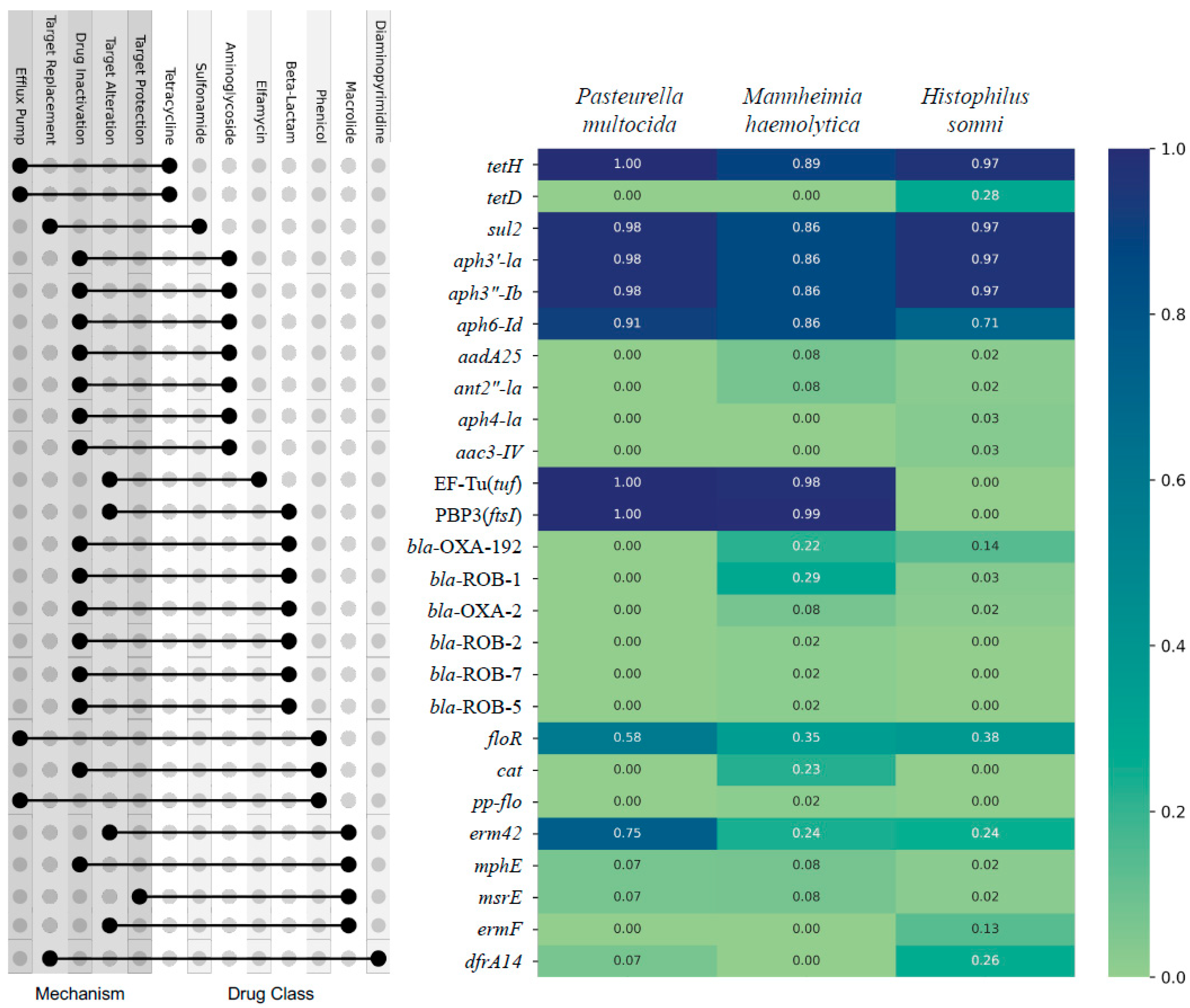
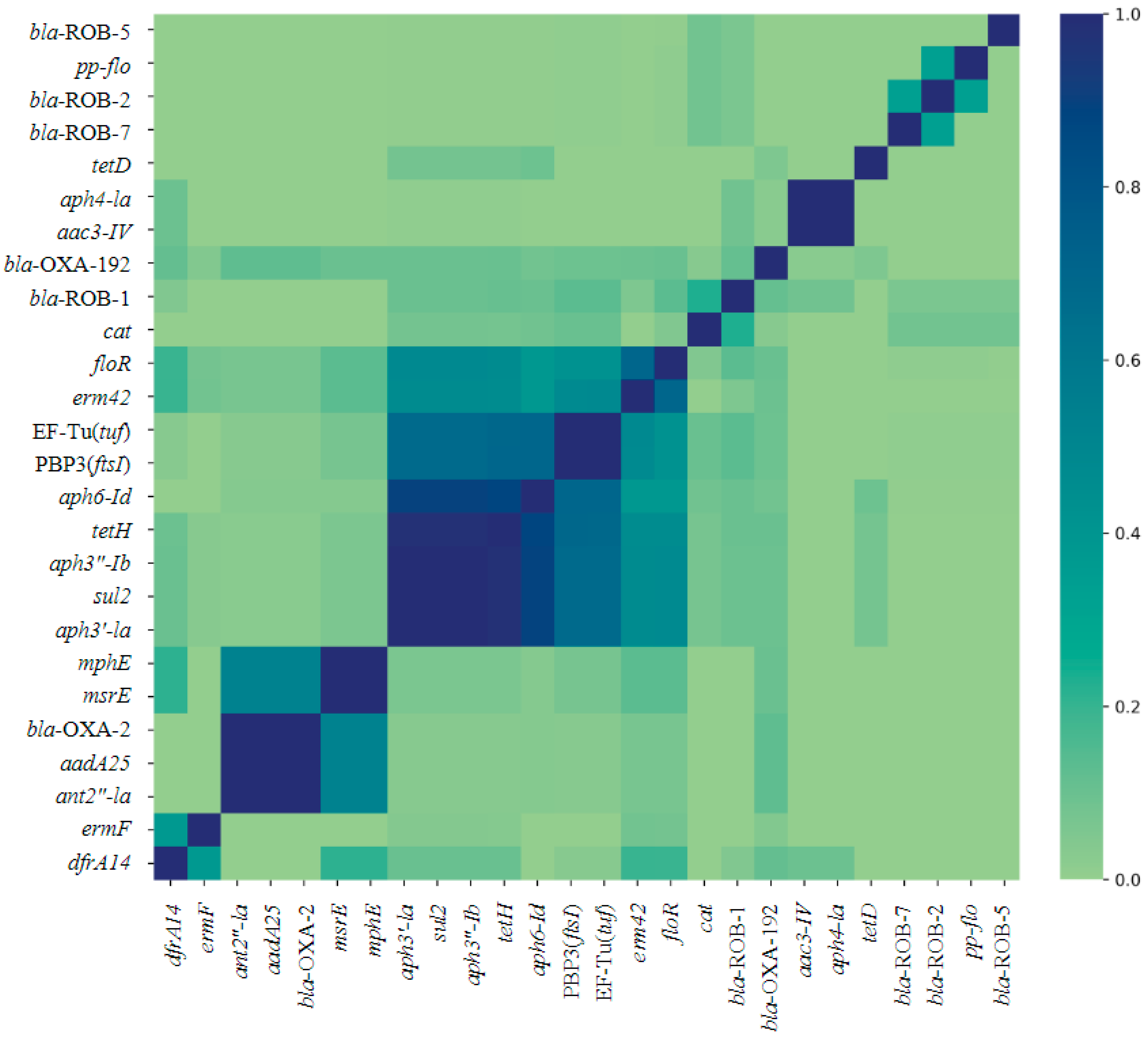
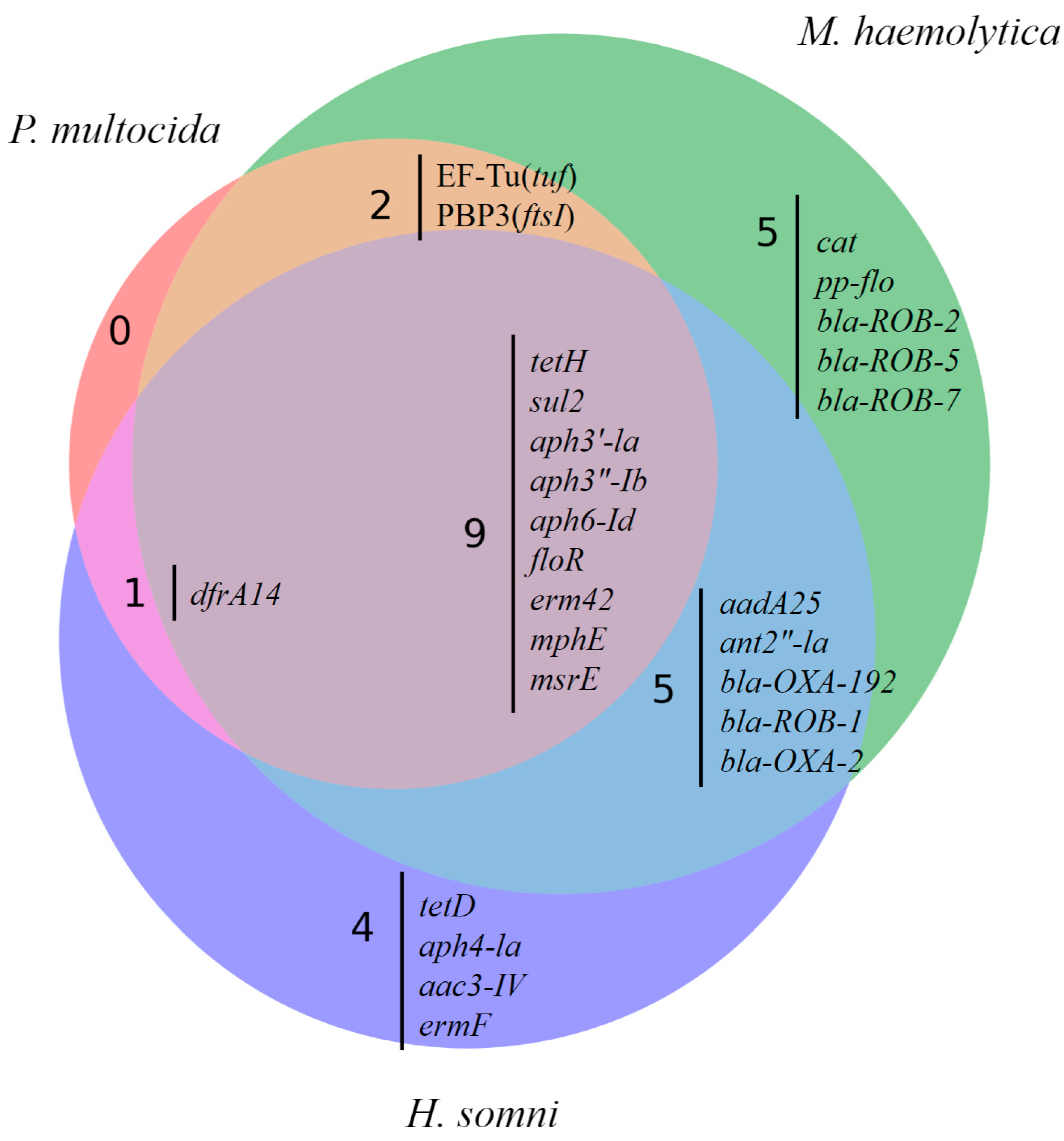
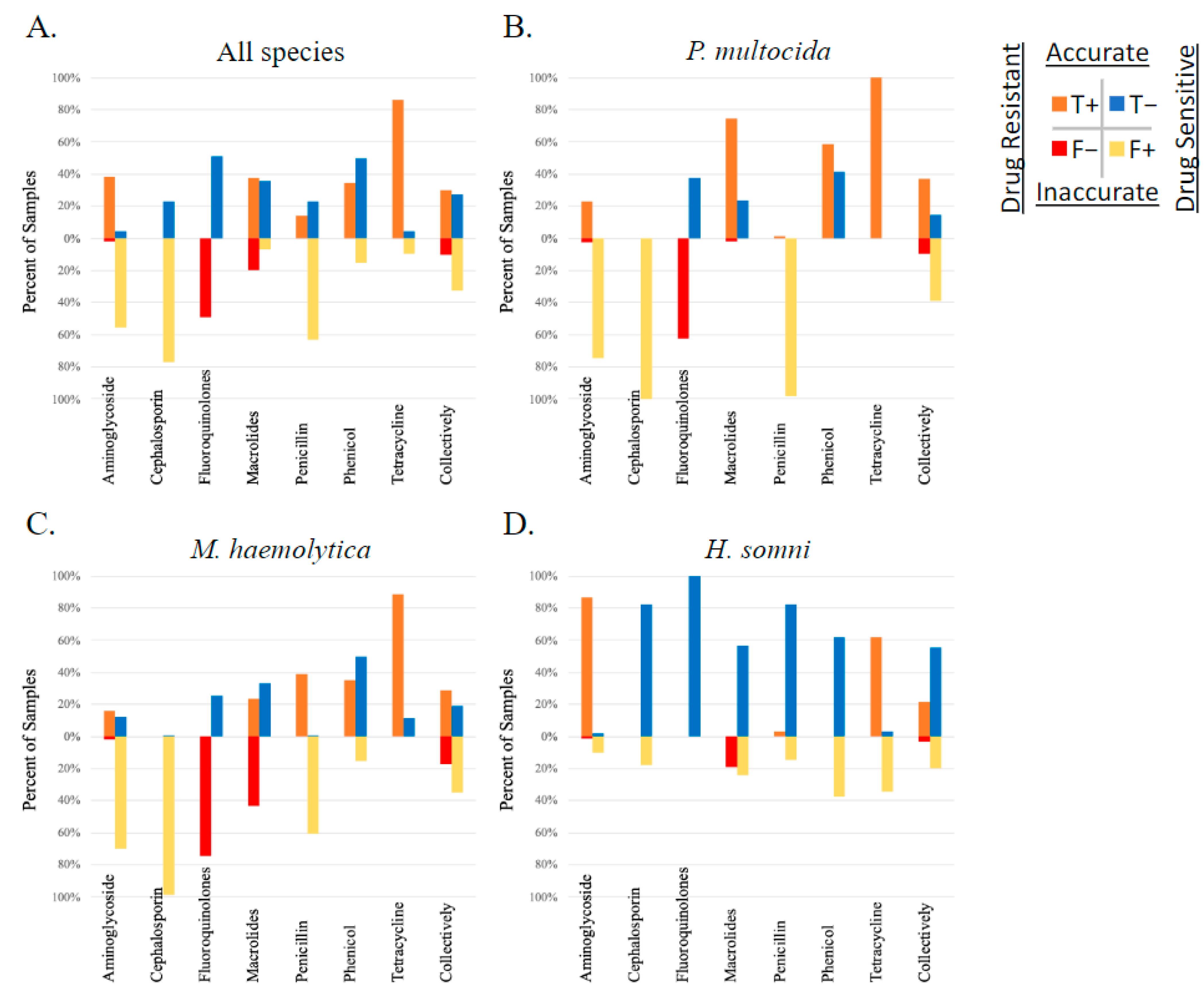

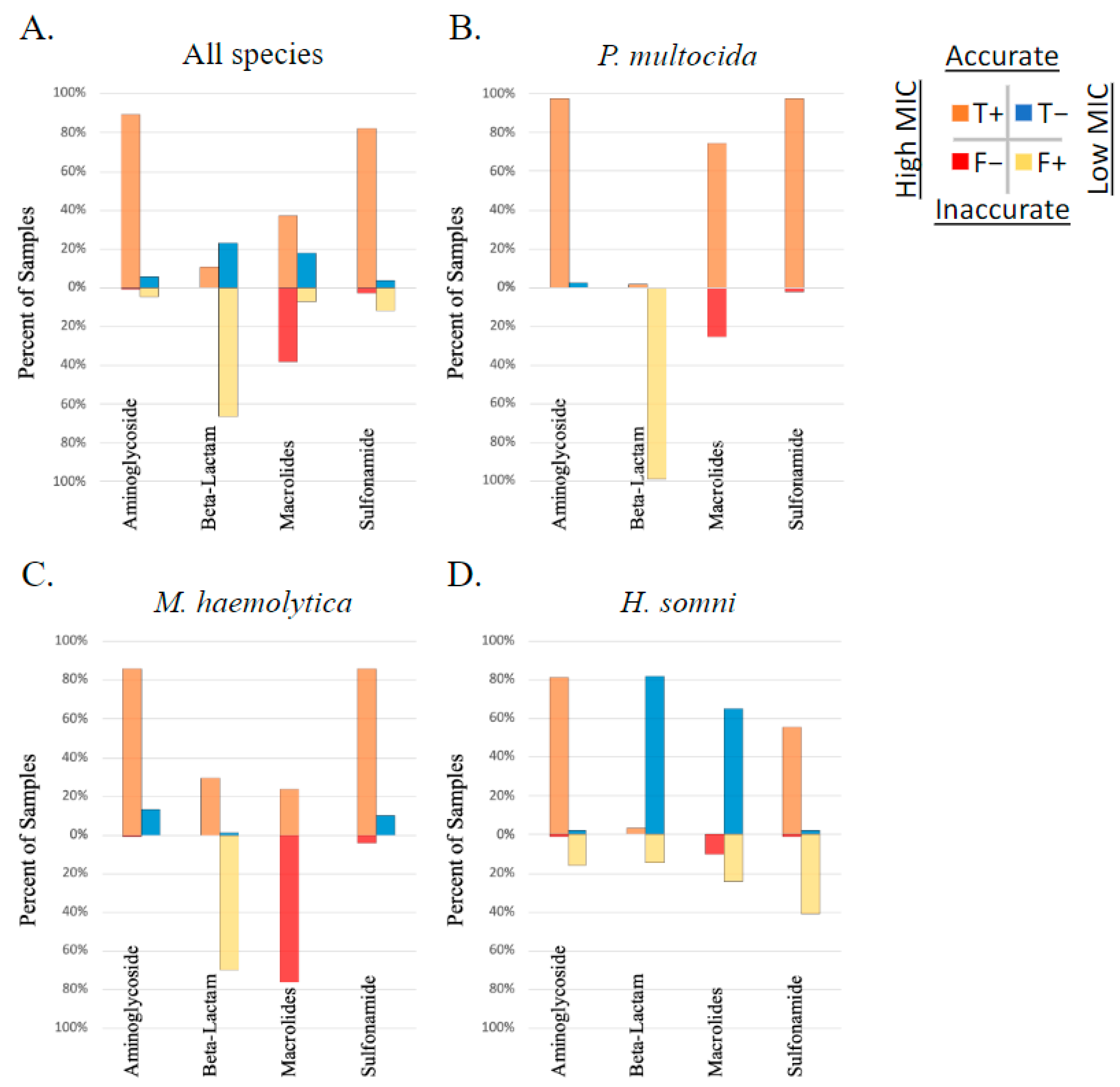
| Drug | Isolate Species | AMR Genes | Matthew’s Correlation Coefficient | Sensitivity | Specificity | McNemar’s p Value |
|---|---|---|---|---|---|---|
| Tilmicosin | P. multocida | erm42 | 0.96 | 0.98 | 1 | 0.5 * |
| mphE | 0.15 | 0.09 | 1 | <0.001 | ||
| msrE | 0.15 | 0.09 | 1 | <0.001 | ||
| M. haemolytica | erm42 | 0.40 | 0.36 | 1 | <0.001 | |
| mphE | 0.20 | 0.11 | 1 | <0.001 | ||
| msrE | 0.20 | 0.11 | 1 | <0.001 | ||
| Gamithromycin | P. multocida | erm42 | 0.92 | 1 | 0.89 | 0.125 * |
| mphE | 0.17 | 0.10 | 1 | <0.001 | ||
| msrE | 0.17 | 0.10 | 1 | <0.001 | ||
| M. haemolytica | erm42 | 0.70 | 0.61 | 1 | <0.001 * | |
| mphE | 0.36 | 0.20 | 1 | <0.001 | ||
| msrE | 0.36 | 0.20 | 1 | <0.001 | ||
| Tulathromycin | P. multocida | erm42 | 0.26 | 1 | 0.31 | <0.001 |
| mphE | 0.60 | 0.41 | 1 | <0.001 * | ||
| msrE | 0.60 | 0.41 | 1 | <0.001 * | ||
| M. haemolytica | erm42 | 0.83 | 0.76 | 1 | 0.008 * | |
| mphE | 0.42 | 0.24 | 1 | <0.001 | ||
| msrE | 0.42 | 0.24 | 1 | <0.001 | ||
| Tildipirosin | P. multocida | erm42 | 1 | 1 | 1 | NDP |
| mphE | 0.16 | 0.09 | 1 | <0.001 | ||
| msrE | 0.16 | 0.09 | 1 | <0.001 | ||
| M. haemolytica | erm42 | 0.50 | 0.42 | 1 | <0.001 | |
| mphE | 0.26 | 0.14 | 1 | <0.001 | ||
| msrE | 0.26 | 0.14 | 1 | <0.001 |
Disclaimer/Publisher’s Note: The statements, opinions and data contained in all publications are solely those of the individual author(s) and contributor(s) and not of MDPI and/or the editor(s). MDPI and/or the editor(s) disclaim responsibility for any injury to people or property resulting from any ideas, methods, instructions or products referred to in the content. |
© 2024 by the authors. Licensee MDPI, Basel, Switzerland. This article is an open access article distributed under the terms and conditions of the Creative Commons Attribution (CC BY) license (https://creativecommons.org/licenses/by/4.0/).
Share and Cite
Depenbrock, S.; Schlesener, C.; Aly, S.; Williams, D.; ElAshmawy, W.; McArthur, G.; Clothier, K.; Wenz, J.; Fritz, H.; Chigerwe, M.; et al. Antimicrobial Resistance Genes in Respiratory Bacteria from Weaned Dairy Heifers. Pathogens 2024, 13, 300. https://doi.org/10.3390/pathogens13040300
Depenbrock S, Schlesener C, Aly S, Williams D, ElAshmawy W, McArthur G, Clothier K, Wenz J, Fritz H, Chigerwe M, et al. Antimicrobial Resistance Genes in Respiratory Bacteria from Weaned Dairy Heifers. Pathogens. 2024; 13(4):300. https://doi.org/10.3390/pathogens13040300
Chicago/Turabian StyleDepenbrock, Sarah, Cory Schlesener, Sharif Aly, Deniece Williams, Wagdy ElAshmawy, Gary McArthur, Kristin Clothier, John Wenz, Heather Fritz, Munashe Chigerwe, and et al. 2024. "Antimicrobial Resistance Genes in Respiratory Bacteria from Weaned Dairy Heifers" Pathogens 13, no. 4: 300. https://doi.org/10.3390/pathogens13040300
APA StyleDepenbrock, S., Schlesener, C., Aly, S., Williams, D., ElAshmawy, W., McArthur, G., Clothier, K., Wenz, J., Fritz, H., Chigerwe, M., & Weimer, B. (2024). Antimicrobial Resistance Genes in Respiratory Bacteria from Weaned Dairy Heifers. Pathogens, 13(4), 300. https://doi.org/10.3390/pathogens13040300









